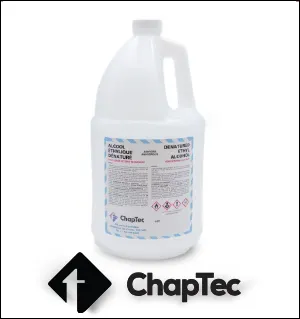Alcohol and tissue
Histology has been processing tissue in essentially the same way for decades. It's a technique that works so well that it has little changed over time.
So, after the tissue has been fixed in, in most cases in an aqueous solution of formaldehyde, the water that the tissue has absorbed, as well as the water it contains naturally must be removed to make the tissue compatible with the solvent and paraffin that will follow and be used for embedding.
The best dehydrating agent found to date is ethyl alcohol or ethanol. It is fast-acting, miscible with water and solvent, and non-toxic. It is so non-toxic that it's subject to numerous taxes and regulatory requirements as states seek to regulate its consumption....
So we eventually saw denatured ethanol appear. It's the same basic product to which an agent has been added to make it unfit for consumption. Chaptec offers ethanol denatured with ethyl acetate.
Other alcohols exist that can also be used for dehydration, but either they don't work as quickly, like isopropyl alcohol, or they are toxic and excessively hygroscopic, like methanol.
Our ethanol is recyclable, a quality that we leverage at Chaptec by distillation of the used alcohol returned to us by customers. It is also offered in different concentrations that are used in increasing sequence to avoid excessive hardening of the tissue. Ethanol is so effective that care must be taken not to leave the tissue standing in it , which would lead to over-dehydration and brittle tissue at the microtome.
But good laboratories master this part of the processing without difficulty, enabling them to use the best product, at the best cost, for well-dehydrated tissue ready for infiltration and inclusion!
Q: After fixation, why must water be removed from tissue?
A: Because paraffin, which is used for embedding, is not compatible with water. The tissue must be dehydrated to become compatible with solvents and paraffin.
Q: What is the best dehydrating agent commonly used?
A: Ethyl alcohol (ethanol). It is fast, miscible with both water and solvents, and is not toxic.
Q: Why is ethanol sometimes denatured?
A: Because pure ethanol is regulated and taxed due to its potential for human consumption. Denatured ethanol contains additives that make it unsuitable for drinking.
Q: Which denaturing agent does Chaptec use?
A: Ethyl acetate.
Q: Why are other alcohols less commonly used for dehydration?
A: Isopropyl alcohol works more slowly, and methanol is toxic and highly hygroscopic.
Q: Can ethanol be recycled?
A: Yes. Chaptec recycles used ethanol returned by clients, offering an environmentally and economically beneficial solution.
Q: Why is ethanol used in progressively increasing concentrations?
A: To avoid excessive tissue hardening and prevent over-dehydration, which would make tissues brittle when sectioned.
| 470, avenue Laurendeau, Montréal-Est (Quebec) H1B 5M2 | |||
| Phone: | 514 498-3620 | Toll free: | 833 498-3620 |
| Email: | chaptec@chaptec.com | ||


